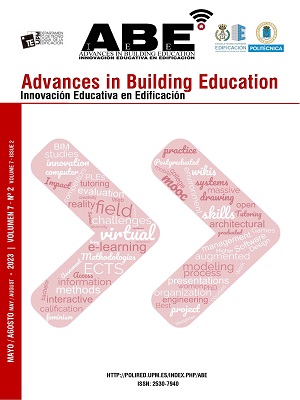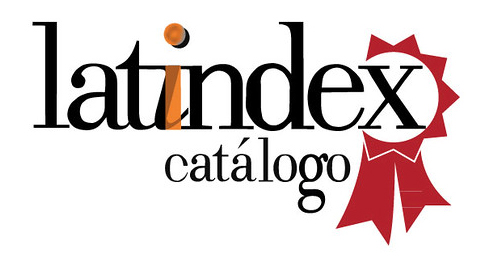Estado del conocimiento técnico y uso de la mampostería en Ecuador Deficiencia de los programas locales de educación superior en ciencias de la construcción = State of technical knowledge and use of masonry in Ecuador Shortcomings of local higher education programs in construction sciences
DOI:
https://doi.org/10.20868/abe.2023.2.5113Keywords:
Mampostería, ladrillo, diseño estructural, sismorresistencia, construcción, educación superior, Masonry, brick, structural design, seismic resistance, construction, higher educationAbstract
El territorio de la República del Ecuador presenta una alta sismicidad. En Ecuador el 95.9% de estructuras de vivienda son construidas con el uso de mamposterías. Se observa que entre los profesionales de la construcción en Ecuador existe un desconocimiento generalizado sobre las propiedades de los materiales constitutivos de las mamposterías y las normas para su diseño estructural. Tal desconocimiento ha generado la proliferación de construcciones que no cumplen con estándares técnicos de sismorresistencia y seguridad estructural, lo que puede generar considerables pérdidas económicas y sobre todo poner en riesgo la integridad física de las personas. El objetivo de esta investigación es determinar de manera cuantitativa la realidad local sobre el conocimiento técnico y uso de mamposterías en Ecuador. Los resultados evidencian principalmente que, el 82% de profesionales de la construcción son profesionales jóvenes; el 33.8% no supera los 30 años de edad; el 51.2% posee una experiencia profesional menor a 5 años; el 71% nunca o casi nunca realiza el diseño estructural incluyendo las mamposterías como elementos del sistema estructural; el 81% nunca recibió contenidos académicos sobre diseño estructural de mamposterías durante sus estudios superiores en Ecuador; existe un desconocimiento generalizado sobre las propiedades mecánicas de los materiales para mamposterías y la norma ecuatoriana para el diseño de mampostería estructural presenta importantes falencias.
Abstract
The territory of the Republic of Ecuador has a high seismicity. In Ecuador, 95.9% of housing structures are built with the use of masonry. It is observed that among construction professionals in Ecuador there is a general lack of knowledge about the properties of the constituent materials of masonry and the standards for their structural design. This lack of knowledge has led to the proliferation of constructions that do not comply with technical standards of seismic resistance and structural safety, which can generate considerable economic losses and, above all, put the physical integrity of people at risk. The objective of this research is to quantitatively determine the local reality of the technical knowledge and use of masonry in Ecuador. The results show that 82% of construction professionals are young professionals; 33.8% are under 30 years of age; 51.2% have less than 5 years of professional experience; 71% never or almost never carry out structural design including masonry as elements of the structural system; 81% never received academic content on structural design of masonry during their higher education in Ecuador; there is a general lack of knowledge about the mechanical properties of masonry materials and the Ecuadorian standard for the design of structural masonry has significant shortcomings.
Downloads
References
Al-Sibahy A, Edwards R (2021) Effect of chases with renovation techniques on the load carrying capacity of masonry walls. Infrastructures 6:. https://doi.org/10.3390/infrastructures6110160
Cajamarca-Zuniga D, Campos D (2023) Definition of the most commonly used ceramic brick for construction in Ecuador: Type and dimensions. Mater Today Proc. https://doi.org/https://doi.org/10.1016/j.matpr.2023.06.299
Caldas V, Sigcha P (2017) Breve análisis cronológico de la introducción de materiales relevantes dentro de las edificaciones del centro histórico de Cuenca entre los años 1880 y 1980. Universidad de Cuenca
Mousourakis A, Arakadaki M, Kotsopoulos S, et al (2020) Earthen architecture in greece: traditional techniques and revaluation
Sharma N, Telang D, Rath B (2017) A Review on Strength of Clay Brick Masonry. Int J Res Appl Sci Eng Technol 5:2620–2626
Radivojević A, Kurtović-Folić N (2006) Evolution of Bricks and Brick Masonry in the Early History of Its Use in the Region of Today’s Serbia. J Mater Civ Eng 18:692–699. https://doi.org/10.1061/(asce)0899-1561(2006)18:5(692)
INEC (2019) Encuesta de Edificaciones 2018. Quito
INEC (2010) Resultados del Censo 2010 de población y vivienda en el Ecuador. Fascículo Provincial Pichincha. Quito
INEC (2010) Resultados del Censo 2010 de pablación y vivienda en el Ecuador. Fascículo Provincial Azuay. Quito
INEC (2010) Resultados del Censo 2010 de población y vivienda en el Ecuador. Fascículo Provincial Guayas. Quito
(1977) NTE INEN 297 Ladrillos Ceramicos Requisitos. Ecuador
(2014) NTE INEN 293 Ladrillos Cerámicos Definiciones. Clasificación y Condiciones Generales. Ecuador
(2015) NTE INEN 292 Ladrillos cerámicos. Muestreo (Clay bricks. Sampling). Ecuador
Cajamarca-Zuniga D, Kabantsev O (2023) Influence of the Carnegie Ridge on the Development of Seismogenic Sources and Seismicity of Ecuador. Lect Notes Civ Eng 282:299–310. https://doi.org/10.1007/978-3-031-10853-2_28
Cajamarca-Zuniga D, Kabantsev O V., Marin C (2022) Macroseismic intensity-based catalogue of earthquakes in Ecuador. Struct Mech Eng Constr Build 18:161–171. https://doi.org/http://doi.org/10.22363/1815-5235-2022- 18-2-161-171
Kabantsev O, Cajamarca-Zuniga D (2023) Proposal for improving the solid clay brick contact surface to increase the initial shear strength of masonry. Mater Today Proc 83:8. https://doi.org/10.1016/j.matpr.2023.05.640
Casas Anguita J, Repullo Labrador JR, Donado Campos J (2003) La encuesta como técnica de investigación. Elaboración de cuestionarios y tratamiento estadístico de los datos (I). Aten. Primaria 31:527–538
INEC (2012) Análisis sectorial: La Industria de la Construcción
NEC-SE-MP (2015) Norma Ecuatoriana de la Construcción. Mampostería Estructural. Ministerio de Desarrollo Urbano y Vivienda, Ecuador
Liu Z, Crewe A (2020) Effects of size and position of openings on in-plane capacity of unreinforced masonry walls. Bull. Earthq. Eng. 18:4783–4812
Dong K, Sui ZA, Jiang J, Zhou X (2019) Experimental study on seismic behavior of masonry walls strengthened by reinforced mortar cross strips. Sustainability 11:19. https://doi.org/10.3390/su11184866
Wang C, Antos SE, Triveno LM (2021) Automatic detection of unreinforced masonry buildings from street view images using deep learning-based image segmentation. Autom Constr 132:. https://doi.org/10.1016/j.autcon.2021.103968
Kázmér M (2019) Living with Earthquakes along the Silk Road. In: Yang LE, Bork HR, Fang X, Mischke S (eds) Socio-Environmental Dynamics along the Historical Silk Road. Springer Nature
Switzerland, Cham, Switzerland, pp 153–176
Dihoru L, Crewe AJ, Liu Z, Taylor CA (2018) Shaking table studies of FRP-reinforced masonry: experimental and numerical results. In: Proccedings of the 16th European Conference on Earthquake Engineering (Geotechnical, Geological, and Earthquake Engineering). Springer Verlag, Thessaloniki, p 12
Medeiros P, Vasconcelos G, Lourenço PB, Gouveia J (2013) Numerical modelling of non-confined and confined masonry walls. Constr Build Mater 41:968–976. https://doi.org/10.1016/j.conbuildmat.2012.07.013
Downloads
Published
Issue
Section
License
ABE (Advances in Building Education / Innovación Educativa en Edificación) does not charge authors for processing or publishing an article and provides immediate Open Access to its content. All content is available free of charge to the user or his institution. Users are permitted to read, download, copy, distribute, print, search or link to the full text of articles, or use them for any other lawful purpose, without prior permission from the publisher or author. This is in accordance with the BOAI definition of open access.
- Authors retain the copyright and grant to the journal the right to a Creative Commons attribution / Non-Commercial / Non-Derivative 4.0 International (CC BY NC ND) License that allows others to share the work with an acknowledgement of authorship and non-commercial use.
- Authors may separately establish additional agreements for the non-exclusive distribution of the version of the work published in the journal (for example, placing it in an institutional repository or publishing it in a book).
Unless otherwise indicated, all contents of the electronic edition are distributed under a Creative Commons license.














